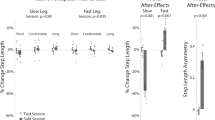Abstract
A biofeedback gait training system for step length is proposed, adapted to the correction of spatial walking asymmetries by means of a simple, quick and reliable method for daily clinical use. The system is composed of a walkway and a gait analysis device (locometer) measuring the main temporal and distance factors of gait. The step length is imposed on the subject by lighted targets appearing on the walkway, alternately on the right and left side; the subject is asked to place a swinging foot on the lighted target. Feedback to the subject is supplied by direct visual information (the subject looking at the movement and the position of the foot with respect to the lighted target) and an acoustic signal delivered in real time when the length step error is greater than an allowed value. The method is validated on a population of hemiparetic patients who have suffered from a stroke and who have been reeducated with traditional rehabilitation methods. The patients were divided into two groups; one group following a gait training with biofeedback (BFB group)_ and one group following a gait training without biofeedback (reference group). Preliminary results are presented, showing a significant beneficial effect of the biofeedback method in increasing the step length of paretic limbs and in correcting step-length asymmetry.
Similar content being viewed by others
References
Basmajian, J. V., (1981): ‘Biofeedback in rehabilitation: a review of principles and practices,’Arch. Phys. Med. Rehabil.,62, pp. 469–475
Bessou, P., Dupui, Ph., Montoya, R., andPages, B. (1989): ‘Simultaneous recording of longitudinal displacements of both feet during human walking,’J. Physiol. Paris,83, pp. 102–110
Bilodeau, E. A. (1966). ‘Acquisition of skill’ inBilodeau (Ed.) (Academic Press, New York)
Colborne, G. R., andOleny, S. J. (1990): ‘Feedback of joint angle and EMG in gait of able-bodied subjects,’Arch. Phys. Med. Rehabil.,71, pp. 478–483
Craik, K. J. W. (1948): ‘Man as an element in a control system,’Brit. J. Psychol.,38, pp. 142–148
Craik, R., andWannstedt, G. (1975): ‘The limb monitor’inHermann, R. (Ed.): Proc. Conf. on Devices and Systems for the Disabled, Philadelphia, Moss Rehabilitation Hospital
Ferrandez, A.-M., Pailhous, J., andDurup, M. (1990): ‘Slowness in elderly gait,’Exp. Aging Res.,16, (2), pp. 79–89
Hirokawa, S., andMatsumura, H. (1989): ‘Biofeedback gait training system for temporal and distance factors,’Med. & Biol. Eng. & Comput.,27, pp. 8–13
Hogue, R., andMcAndless, S. (1983): ‘Genu-recurvatum: auditory biofeedback treatment for adult patients with stroke or head injuries,’Arch. Phys. Med. Rehabil.,64, pp. 368–370
Larsson, L. E., Odendrick, P., Sandlund, B., Weitz, P., andÖberg, P. A. (1980): ‘The phases of the stride and their interaction in human gait,’Scand. J. Rehab. Med.,12, pp. 107–112
Melvill Jones, G., andMandl, G. (1983): ‘Neurobionomics of adaptive plasticity: integrating sensorimotor function with environmental demands,’inDesmedt, J. E. (Ed.). Motor control mechanisms in health and disease’ (Raven Press, New York)
Murray, M. P. (1967). ‘Gait as a total pattern of movement,’Am. J. Phys. Med.,46, pp. 290–333.
Murray, M. P., Kory, R. C., andClarkson, B. H. (1969): ‘Walking patterns in healthy old men,’J. Geront.,24, pp. 169–178
Seeger, B., Caudrey, D., andScholes, J. (1981): ‘Biofeedback therapy to achieve symmetrical gait in hemiplegic cerebral palsied children,’Arch. Phys. Med. Rehabil.,62, pp. 364–368
Spearing, D. L., andPoppen, R. (1974): ‘The use of feedback in the reduction of foot dragging in a cerebral palsied client,’J. Nerv. Ment. Dis.,159, pp. 148–151
Wannstedt, G., andHermann, R. M. (1978): ‘Use of augmented sensory feedback to achieve symmetry standing,’Phys. Ther.,58, pp. 553–559
Warren, C. G., andLehmann, J. F. (1975): ‘Auditory feedback from limb and crutch used to control weight bearing during ambulation,’Arch. Phys. Med. Rehabil.,56, pp. 567–570
Author information
Authors and Affiliations
Rights and permissions
About this article
Cite this article
Montoya, R., Dupui, P., Pagès, B. et al. Step-length biofeedback device for walk rehabilitation. Med. Biol. Eng. Comput. 32, 416–420 (1994). https://doi.org/10.1007/BF02524694
Received:
Accepted:
Issue Date:
DOI: https://doi.org/10.1007/BF02524694




